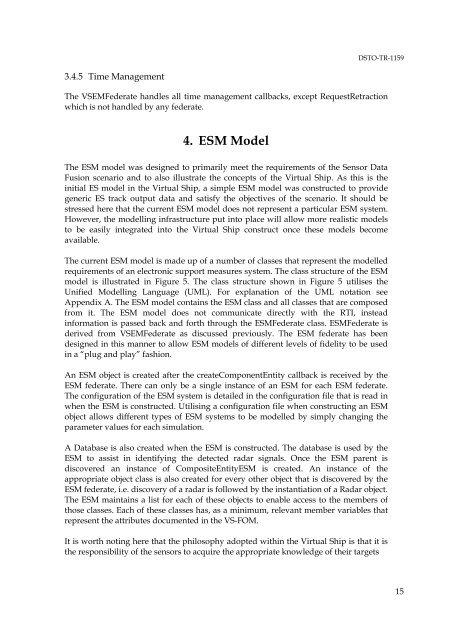O - Defence Science and Technology Organisation
O - Defence Science and Technology Organisation
O - Defence Science and Technology Organisation
Create successful ePaper yourself
Turn your PDF publications into a flip-book with our unique Google optimized e-Paper software.
DSTO-TR-1159<br />
3.4.5 Time Management<br />
The VSEMFederate h<strong>and</strong>les all time management callbacks, except RequestRetraction<br />
which is not h<strong>and</strong>led by any federate.<br />
4. ESM Model<br />
The ESM model was designed to primarily meet the requirements of the Sensor Data<br />
Fusion scenario <strong>and</strong> to also illustrate the concepts of the Virtual Ship. As this is the<br />
initial ES model in the Virtual Ship, a simple ESM model was constructed to provide<br />
generic ES track output data <strong>and</strong> satisfy the objectives of the scenario. It should be<br />
stressed here that the current ESM model does not represent a particular ESM system.<br />
However, the modelling infrastructure put into place will allow more realistic models<br />
to be easily integrated into the Virtual Ship construct once these models become<br />
available.<br />
The current ESM model is made up of a number of classes that represent the modelled<br />
requirements of an electronic support measures system. The class structure of the ESM<br />
model is illustrated in Figure 5. The class structure shown in Figure 5 utilises the<br />
Unified Modelling Language (UML). For explanation of the UML notation see<br />
Appendix A. The ESM model contains the ESM class <strong>and</strong> all classes that are composed<br />
from it. The ESM model does not communicate directly with the RTI, instead<br />
information is passed back <strong>and</strong> forth through the ESMFederate class. ESMFederate is<br />
derived from VSEMFederate as discussed previously. The ESM federate has been<br />
designed in this manner to allow ESM models of different levels of fidelity to be used<br />
in a “plug <strong>and</strong> play” fashion.<br />
An ESM object is created after the createComponentEntity callback is received by the<br />
ESM federate. There can only be a single instance of an ESM for each ESM federate.<br />
The configuration of the ESM system is detailed in the configuration file that is read in<br />
when the ESM is constructed. Utilising a configuration file when constructing an ESM<br />
object allows different types of ESM systems to be modelled by simply changing the<br />
parameter values for each simulation.<br />
A Database is also created when the ESM is constructed. The database is used by the<br />
ESM to assist in identifying the detected radar signals. Once the ESM parent is<br />
discovered an instance of CompositeEntityESM is created. An instance of the<br />
appropriate object class is also created for every other object that is discovered by the<br />
ESM federate, i.e. discovery of a radar is followed by the instantiation of a Radar object.<br />
The ESM maintains a list for each of these objects to enable access to the members of<br />
those classes. Each of these classes has, as a minimum, relevant member variables that<br />
represent the attributes documented in the VS-FOM.<br />
It is worth noting here that the philosophy adopted within the Virtual Ship is that it is<br />
the responsibility of the sensors to acquire the appropriate knowledge of their targets<br />
15

















